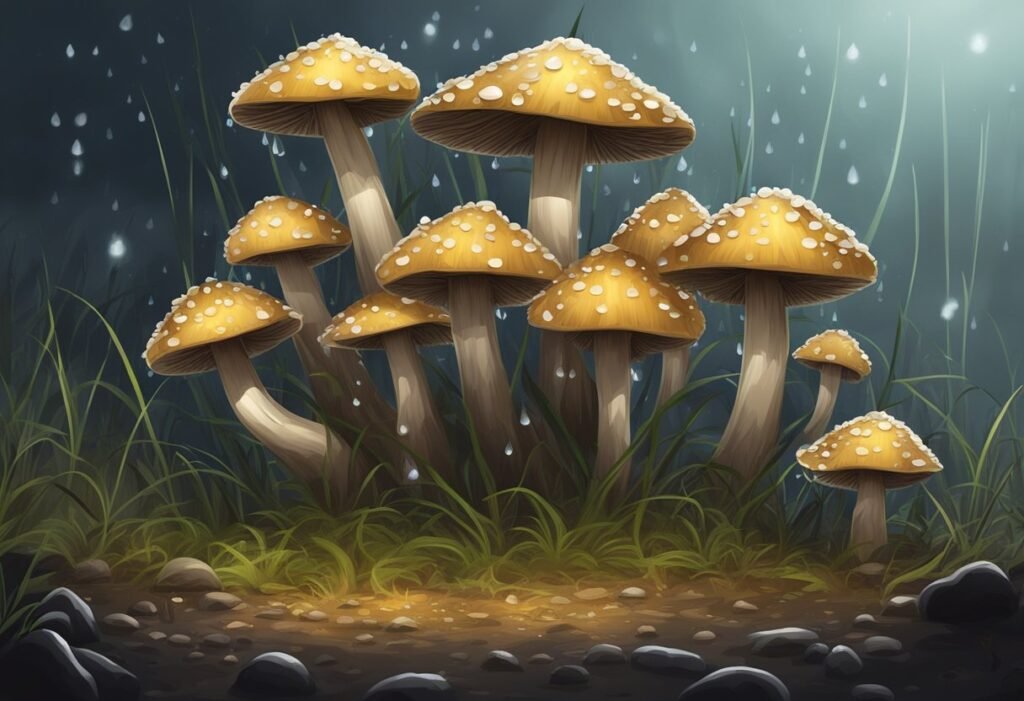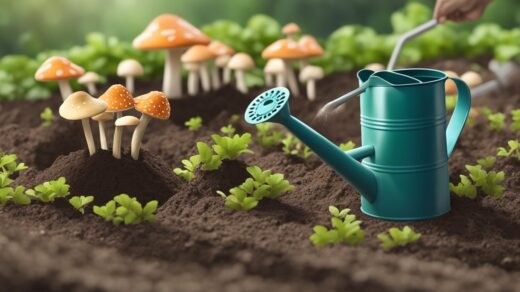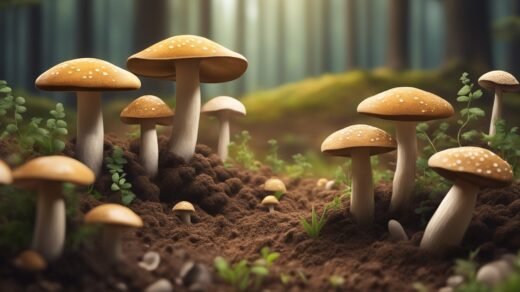Growing your own mushrooms at home can be a fun and rewarding experience. Straw mushrooms are a popular variety that can easily be grown in your own backyard. With the right materials and techniques, you can enjoy fresh, homegrown mushrooms in no time.
To get started, you will need to gather some supplies. Straw mushrooms grow best on a substrate of straw or other plant material. You will also need a container to grow the mushrooms in, such as a plastic bag or a container with holes for ventilation. A spray bottle filled with water will be necessary to keep the substrate moist during the growing process.
Once you have gathered your supplies, it is time to prepare the substrate and inoculate it with mushroom spores. With a little patience and attention to detail, you can successfully grow your own straw mushrooms at home.
Understanding Straw Mushrooms

Species Overview
Straw mushrooms (Volvariella volvacea) are a type of edible mushroom that belongs to the family Pluteaceae. They are also known as paddy straw mushrooms, rice straw mushrooms, or Chinese mushrooms. These mushrooms are native to Southeast Asia and are widely cultivated in countries like Thailand, Vietnam, and China.
Straw mushrooms have a distinctive appearance. They have small, white to light brown caps with a diameter of 2-5 cm and long, slender stems that are usually 5-10 cm long. The caps are covered with a thin, white veil when young, which breaks as the mushroom matures, leaving a ring-like structure around the stem.
Health Benefits
Straw mushrooms are not only delicious but also offer several health benefits. They are low in calories and high in protein, making them an excellent food choice for vegetarians and people on a low-calorie diet. They are also rich in vitamins B and C, potassium, and selenium, which are essential for maintaining good health.
Studies have shown that straw mushrooms contain bioactive compounds that have antioxidant, anti-inflammatory, and anticancer properties. These compounds can help protect against various diseases, including cancer, heart disease, and diabetes.
Culinary Uses
Straw mushrooms are a versatile ingredient and can be used in various dishes. They have a mild, slightly nutty flavor and a firm, meaty texture, which makes them a great addition to soups, stir-fries, and curries. They are also a popular choice for vegetarian and vegan recipes.
Straw mushrooms are easy to cook and can be sautéed, grilled, or roasted. They can be used fresh or canned, and the canned variety is readily available in most grocery stores. When using canned straw mushrooms, it is essential to drain and rinse them thoroughly to remove any excess salt or preservatives.
In conclusion, straw mushrooms are a delicious and nutritious ingredient that can be easily grown at home. They offer several health benefits and are a great addition to any recipe.
Preparing for Cultivation

Choosing a Growing Medium
To grow straw mushrooms at home, one must first choose a suitable growing medium. Straw is the most common medium used for cultivating straw mushrooms. Other alternatives to straw include sawdust, corn cobs, and coffee grounds. However, straw is the most preferred medium because it is readily available, affordable, and easy to use.
Selecting Quality Spores
The next step in preparing for cultivation is selecting quality spores. High-quality spores are essential for successful cultivation. It is recommended to purchase spores from a reputable source to ensure quality and purity. When selecting spores, look for those that are fresh, viable, and free from contaminants.
Creating the Ideal Environment
Creating the ideal environment is crucial for the growth and development of straw mushrooms. The ideal temperature for straw mushroom cultivation is between 75-85°F (24-29°C) with a humidity level of 80-90%. The growing area should be well-ventilated to allow for proper air circulation. Additionally, it is important to keep the growing area clean and free from contaminants to prevent the growth of harmful bacteria and fungi.
In summary, to prepare for straw mushroom cultivation, one must choose a suitable growing medium, select quality spores, and create the ideal environment. By following these steps, one can increase the chances of a successful harvest.
The Growing Process
Growing straw mushrooms at home is a fun and rewarding experience. Here are the steps to follow to ensure a successful harvest.
Spore Inoculation
The first step in growing straw mushrooms is to inoculate the straw with mushroom spores. This can be done by purchasing a spore syringe or making your own spore solution. Once you have your spores, you will need to sterilize your straw to prevent contamination.
To sterilize your straw, you can use a pressure cooker or a large pot. Fill the pot with water and bring it to a boil. Add the straw and let it boil for 10-15 minutes. Drain the straw and let it cool to room temperature.
Next, mix your spores with water to create a spore solution. Add the spore solution to the straw and mix well. Make sure the straw is evenly coated with the spore solution.
Incubation
After inoculating the straw, it’s time to incubate it. Place the straw in a plastic bag and seal it. Poke a few holes in the bag to allow for air circulation.
Place the bag in a warm, dark place such as a closet or cabinet. The ideal temperature for incubation is between 75-85°F. Check on the bag every few days to make sure the straw is not drying out.
Maintaining Humidity and Temperature
Once the mycelium has colonized the straw, it’s time to move the bag to a fruiting chamber. This can be a plastic container or a grow tent. The fruiting chamber should be kept at a temperature of 75-85°F with a humidity level of 80-90%.
To maintain humidity, mist the inside of the fruiting chamber with a spray bottle. Make sure the straw is not getting too wet or too dry. Check on the mushrooms daily and harvest them when they are fully grown.
By following these steps, you can successfully grow straw mushrooms at home and enjoy a delicious and nutritious harvest.
Harvesting and Storage
Identifying Harvest Time
Straw mushrooms are ready to be harvested when their caps have fully opened and the gills underneath the cap are visible. The cap should be firm and not too soft or mushy. If the cap has started to flatten out, it may be too late to harvest. It is important to harvest the mushrooms at the right time to ensure that they are at their peak flavor and texture.
Proper Harvesting Technique
When harvesting straw mushrooms, it is important to use a sharp knife or scissors to cut the stem close to the base of the mushroom. Pulling the mushroom out of the ground can damage the surrounding mycelium and reduce future yields. Be sure to handle the mushrooms gently to avoid bruising or damaging them.
Storing Straw Mushrooms
After harvesting, it is important to store straw mushrooms properly to ensure that they stay fresh and retain their flavor. The mushrooms should be stored in a cool, dry place, such as the refrigerator, for up to one week. It is best to store them in a paper bag or wrapped in a paper towel to absorb any excess moisture. Avoid storing them in a plastic bag, as this can cause them to become slimy and spoil quickly.
To extend the shelf life of the mushrooms, they can be blanched and frozen for later use. To blanch the mushrooms, simply boil them in water for 2-3 minutes, then immediately plunge them into ice water to stop the cooking process. Drain the mushrooms and place them in a freezer-safe container or bag. They can be stored in the freezer for up to 6 months. When ready to use, simply thaw them in the refrigerator and use as desired.
Overall, harvesting and storing straw mushrooms is a relatively simple process that can be easily mastered with a little bit of practice. By following these guidelines, you can ensure that your mushrooms are at their peak flavor and texture, and can be enjoyed for weeks to come.
Troubleshooting Common Issues
Pest and Disease Management
Mushrooms are susceptible to a wide range of pests and diseases, which can quickly destroy your crop if not addressed promptly. One of the most common pests is the mushroom fly, which lays its eggs on the surface of the substrate. To prevent infestations, it is important to maintain a clean growing environment and to remove any contaminated substrate immediately.
Another common problem is bacterial blotch, which causes brown spots to form on the mushrooms. To prevent this, it is important to maintain proper air circulation and to avoid overcrowding the growing area. If you notice any signs of bacterial blotch, remove the affected mushrooms immediately to prevent the spread of the disease.
Addressing Poor Growth
If your mushrooms are not growing as expected, there are several factors that may be contributing to the problem. One common issue is inadequate moisture, which can cause the mushrooms to dry out and stop growing. To address this, make sure to mist the growing area regularly and to maintain a high level of humidity.
Another issue may be insufficient nutrients in the substrate. To address this, consider adding additional nutrients such as straw or compost to the substrate. It is also important to maintain a consistent temperature and to avoid exposing the growing area to direct sunlight.
Environmental Control Adjustments
Maintaining the proper environmental conditions is critical to the success of your mushroom crop. If you notice that the temperature or humidity levels are not optimal, consider making adjustments to the growing area. For example, you may need to add a humidifier or a fan to maintain the proper conditions.
It is also important to monitor the pH level of the substrate, as mushrooms require a slightly acidic environment to thrive. If the pH level is too high or too low, you may need to adjust it using a pH meter or by adding lime or sulfur to the substrate.
By addressing these common issues and maintaining proper growing conditions, you can ensure a successful harvest of delicious and nutritious straw mushrooms.




